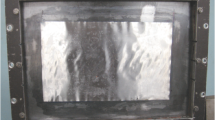Lathes are distinguished by high performance and increased noise levels. Reduction of this noise is achieved in different ways. Use of damping metallic materials is an effective way. Metal damping materials are distinguished from analogs (non-metallic materials) by high strength properties. Often non-metallic damping materials cannot replace steels and alloys due to low operating temperature and other physicomechanical properties. Steel damping properties are rarely investigated, and this limits the use of these alloys. Designers and engineers do not have information about damping properties of well-known steels. Properties of developed damping steels are investigated. Damping bushes of monolithic and bimetal structures are tested.



Similar content being viewed by others
References
E. B. Utepov, V. Yu. Lidtke, V. M. Myakotin, et al., Noise Reduction in Automatic Lathe Guide Tubes, Print, Almaty (2000).
Yu. M. Il’yashchuk, D. Kh. Slobodkin, and Z. V. Trandina, “Study of features of noise formation in automatic longitudinal turning guide tubes,” in: Scientific Works of VTsSPS Institutes for Labour Protection, Profizdat, Moscow (1973).
E. N. Utepov, “Automatic lathe guide tube with reduced sound emission,” Proc. 14th Int. Sci.-Tech. Conf. Technosphere Safety (labour protection, protection against emergencies, life safety, ecology, damping alloy materials science, general engineering questions, economic and juridical aspects of life safety), NITU MISiS, Moscow (2012), Vol. 3, pp. 135–144.
E. B. Utepov, D. K. Sulaev, and T. E. Utepov, Scientific Bases of Creating “Silent” Alloys (problems of acoustic ecology), Print, Almaty (2000).
E. B. Utepov, A. T. Madizhanova, M. K. Malgazhdarova, and Sh. B. Egemova, “Study of alloyed steel acoustic properties,” Metallurg, No. 8, 92–95 (2014).
H. Cremer and C. Cremer, “Theorie der Entstehung des Klopfschalls,” Frequenz, 2, No. 3, 61–71 (1948).
E. B. Utepov, D. K. Sulaev, G. A. Urikbaeva, and G. E. Utepov, Use of Damping Nanostructured Materials in Technology for Combatting Noise and Vibration, KazNITU im. Satpaeva, Almaty (2008).
Author information
Authors and Affiliations
Corresponding author
Additional information
A. Zh. Alimbetova, A. B. Isakhanova, S. Zh. Karipbaev, M. K. Baizhumanov, D. K. Suleev, and T. E. Utepov took part in this work.
Translated from Metallurg, No. 9, pp. 63–67, September, 2016.
Rights and permissions
About this article
Cite this article
Utepov, E.B., Ten, E.B., Zhumadilova, Z.O. et al. Damping Metallic Materials with a Nanostructured Coating. Metallurgist 60, 961–966 (2017). https://doi.org/10.1007/s11015-017-0392-1
Received:
Published:
Issue Date:
DOI: https://doi.org/10.1007/s11015-017-0392-1




